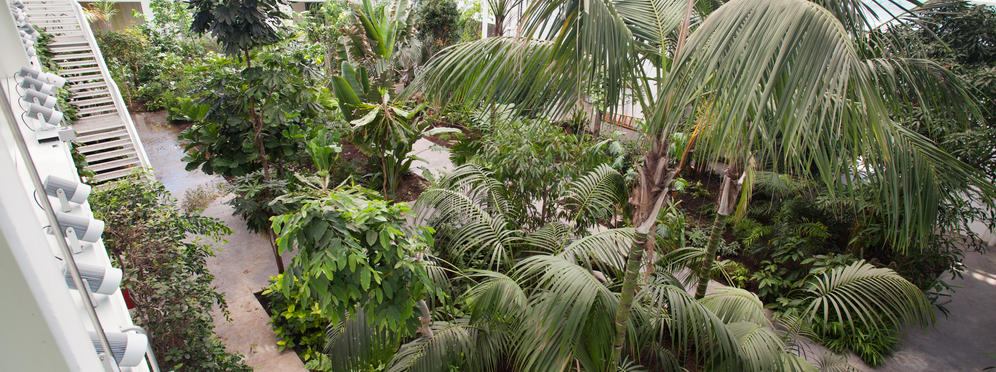Plants and the Environment
A wood. The sea. A beach. Even city parks and gardens…all are ecosystems.

Each centimetre of our planet can be an ecosystem, or more simply, part of one. For example, the temperate forest which covers areas as far apart as much of Europe, Asia and north America is an ecosystem. But individual ecosystems are not separated by rigid boundaries and at different times, organisms can “transit” from one ecosystem to another. The fluidity of nature leads us to use simpler forms of identification. This is where terrestrial biomes come in. Almost as in a snapshot, they unite “near” ecosystems, characterised by the same environmental conditions, although perhaps very far apart in purely geographical terms. The new greenhouse thus takes the visitor on an imaginary journey from the Equator to the Poles.
Tropical rain forest
The tropical rain forest extends from the Tropic of Cancer to the Tropic of Capricorn. With an average temperature of about 25°C and oscillations of 2-4° during the year, rainfall is so abundant that in most of the areas it reaches 2,500 mm per year. Tropical rainforests cover just 7% of the Earth’s surface, but according to estimates, they contain more than 50% of the planet’s biodiversity.
Sub-humid tropical forest and savannah
Precipitation in the sub-humid climate zone and savannah is lower than in the rainforest, with values of just over 800 mm per year. The average temperature drops below 20°C, with oscillations of some ten or so degrees over the twelve month period. The sub-humid climate is typical of the Indian subcontinent, south-east Asia and southern China, but also the African jungle (such as in the Gulf of Guinea or the Congo Basin), central America along the Atlantic coast and in some areas of south America, such as Venezuela. The savannah is a plant formation present in some areas of eastern and central Africa, in Guyana and in Australia.
Temperate and Mediterranean climate
Temperate climates are characterised by cool winters, warm summers, and high year-round precipitation. Biodiversity is relatively high due to the niche partitioning allowed by the multiple forest layers. More complex forests are associated with a greater number of animal species. The Mediterranean is the least extensive of the temperate climates and can be found in southern Italy, Sicily and Sardinia and in the coastal areas of Spain and France. But similar climatic conditions occur along the coasts of Turkey and in the Near East, the Maghreb, the Cape region, California, Chile and south west Australia. Temperate climate zones cover less than 2% of the Earth’s surface. They are threatened by heavy pressure from man, but contain 20% of the entire wealth of biodiversity.
Arid climate
Arid climates are characterised by scarce precipitation (less than 250 mm of water per year), but there are hot arid climates and cold arid climates. The first are typical of north Africa, the Arabian peninsula, certain parts of north America, Chile and Australia. An example of the second is the entire zone stretching from the Caspian Sea to the Gobi Desert in Mongolia.






